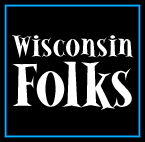|
Polish-style Polka Band
Stevens Point, WI
Vocabulary
Arrangement: The written plan for how musicians will play songs together.
Book: To hire a performer.
Bandstands: A stand that holds sheet music and sometimes has the name of the band on it.
Concertina: (sounds like, con-sir-TEE-na) A musical instrument like an accordion but with buttons.
Energetic: Full of energy, excited.
Establish: To set up.
Fluently: Able to speak without much difficulty and with few mistakes.
Folk songs: Songs passed on from person to person and usually not written down.
Generations: People in a family who are around the same age. For example, you, your siblings, and your cousins are of one generation. Your parents, aunts and uncles are of another generation.
“Honky style polka”: A Polish-American style of polka that is slower than other styles. Honky bands have a reed player (saxophone or clarinet) who plays call and response with the trumpet.
Immigrants: People who move from one country or region to another.
Interact: To get involved with.
Language retention: Continuing to speak the language of your ancestors.
Melodic instruments: (sounds like, Meh-LA-dic) Instruments that play the tune of a song.
Polish-American: People in the United States who have family that came from Poland.
Polka: A lively couple’s dance.
Records: Discs with grooves that play music.
Rehearse: To practice.
Repertoire: (Sounds like, REP-er-twar) The list of songs that the band knows how to play.
Rhythm: Flow of sound patterns.
Up a storm: To do something a lot.
back to top
Journal Questions
 Listen to the Happy Notes’ music. (Use a Wisconsin Folks audio clip or the video
clip to listen.) Describe how the music makes you feel, how you want to move your body in response to the music, what the music makes you think about. Listen to the Happy Notes’ music. (Use a Wisconsin Folks audio clip or the video
clip to listen.) Describe how the music makes you feel, how you want to move your body in response to the music, what the music makes you think about.
back to top
Resources For Teachers
 Polka: Wisconsin’s State Dance is
an article by Dr. Richard March about the history and culture of polka in Wisconsin. Norm Dombrowski and the Happy Notes are featured, along with other musicians. This article is on PBS’
River of Song website. Polka: Wisconsin’s State Dance is
an article by Dr. Richard March about the history and culture of polka in Wisconsin. Norm Dombrowski and the Happy Notes are featured, along with other musicians. This article is on PBS’
River of Song website.
 The article “Polka: Changes
and Developments through the Years” gives a good history of this musical
genre including explanations of the Polish-American Eastern, Honky and Push
styles. The author is Wisconsin polka musician Mollie Busta. The article “Polka: Changes
and Developments through the Years” gives a good history of this musical
genre including explanations of the Polish-American Eastern, Honky and Push
styles. The author is Wisconsin polka musician Mollie Busta.
 Polka is also a dance style. The article,
“Polka” gives a brief history of the polka dance. The article,
“Polish Dances: Polka” by Maja Trochimczyk is more in-depth. Polka is also a dance style. The article,
“Polka” gives a brief history of the polka dance. The article,
“Polish Dances: Polka” by Maja Trochimczyk is more in-depth.
 “The
Old Neighborhood Isn’t the Same Anymore” is a chapter from the book Polish American Folklore by Deborah Anders Silverman (2000; University of Illinois Press). This chapter focuses on how
Polish-American ethnic identity has changed over time. “The
Old Neighborhood Isn’t the Same Anymore” is a chapter from the book Polish American Folklore by Deborah Anders Silverman (2000; University of Illinois Press). This chapter focuses on how
Polish-American ethnic identity has changed over time.
 My Harvest Home: A Celebration of Polish Culture My Harvest Home: A Celebration of Polish Culture
By Andrea Schafer, 76 pp.
This book and CD/cassette set explores favorite Polish-American songs, dances, games, sayings and customs that originate from different regions of Poland. The book suggests related activities for
students.
Available through the
Polish Art Center.
back to top
Resources For Students
 Go to Poland in the Classroom
and explore the history, geography, legends, food and folk arts of Poland. Go to Poland in the Classroom
and explore the history, geography, legends, food and folk arts of Poland.
 Do you think there are many many Polish-American organizations and businesses in Wisconsin? Find out
at Wisconsin’s Polish Community. Do you think there are many many Polish-American organizations and businesses in Wisconsin? Find out
at Wisconsin’s Polish Community.
 The Polish Polka Page will let
you link to websites of bands that play Polish-style polka. The Polish Polka Page will let
you link to websites of bands that play Polish-style polka.
 Three annual Polish-American festivals in Wisconsin that feature lots of great Polish-style polka
are Milwaukee’s Polish Fest, Wisconsin Dells’ Polish Fest, and
Pulaski’s Polka Days. Try to attend! Three annual Polish-American festivals in Wisconsin that feature lots of great Polish-style polka
are Milwaukee’s Polish Fest, Wisconsin Dells’ Polish Fest, and
Pulaski’s Polka Days. Try to attend!
back to top
Credits
Text written by Rick March, edited by Anne Pryor and Jamie Yuenger.
Sources consulted include footage from Wisconsin Folks (1998), a video produced by Dave Erickson for Wisconsin Arts Board and Wisconsin Public Television.

|


